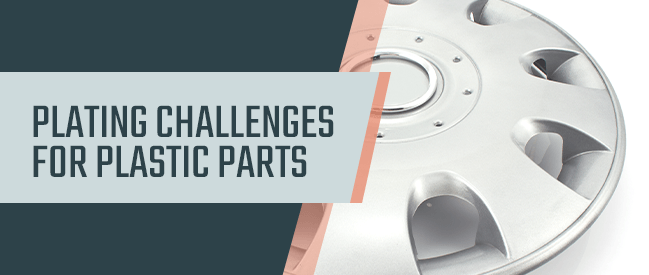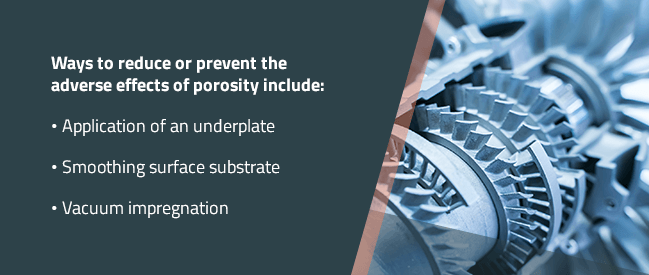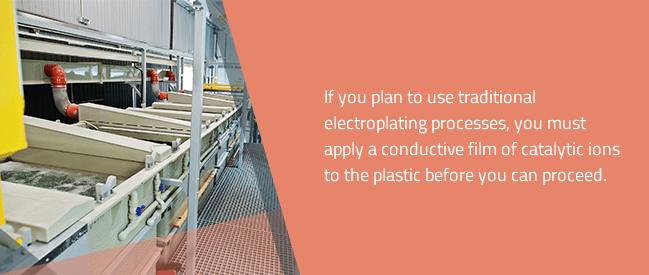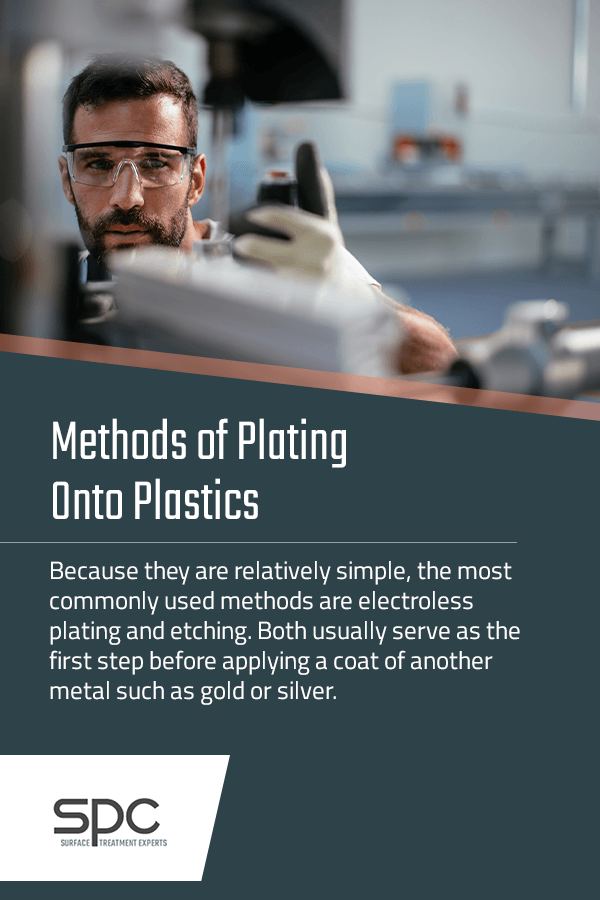Plating onto plastic parts is a technique that was pioneered in response to the industrial demands of World War II.1 Now, in the 21st century, it is experiencing a resurgence in popularity — from 2022 to 2028, the electroless plating market size is expected to grow at a compound annual growth rate (CAGR) of 3.1%.2 Common applications for plating onto plastics include semiconductors, automotive manufacturing, consumer electronics and plumbing fixtures manufacturing.3
In addition to enabling conductivity for plastic parts, plating onto plastic is beneficial for manufacturing applications because it allows y4u to add an extra layer of protection against harsh plant chemicals and corrosion. It also improves strength and wear resistance, resulting in more durable parts.
However, due to plastic’s unique characteristics, many manufacturers run into plating challenges for plastic components. This post will explain those challenges and present viable solutions for a variety of industries.
Challenges of Plating Plastic Parts
Plastic presents unique challenges to metal finishing applications due to its chemical composition and characteristics. Most plastics fall under one of two categories:
- Thermoplastics: Thermoplastics, such as polyvinyl chloride (PVC) and acrylic, are polymers that become flexible when exposed to heat and solidify in cooler temperatures.4 They can repeat this process many times.
- Thermosets: Unlike thermoplastics, thermosets harden permanently in response to heat.5 These plastics tend to be more durable thanks to their covalent bond structures. Examples include epoxy resin, polyurethane and vulcanized rubber.
Because each type of plastic responds differently to heat, your approach should differ depending on the type you are using. For example, thermosets are more suited to applications involving high heat, such as plating. However, some thermoplastics can be plated.
Additionally, plastic is an insulating material, so it does not conduct electricity as metal does.6 As a result, the electrically charged ions produced by the DC current during electroplating will not adhere to a plastic surface. A conductive film must be applied to a plastic surface through specialized processes before the piece can undergo traditional electroplating.
Last, plating onto plastics can be complicated due to how density affects 3-D printed parts. A part’s infill density — also known as its infill percentage — makes it porous, which can negatively affect electroplating by weakening the part.
The term infill refers to the material inside of a manufactured part.7 It can take a variety of grid patterns depending on the desired density and tensile strength, including squares, stars or hexagons. As the infill percentage increases, so does part strength. Parts with lower infill percentages are more likely to become distorted during the electroplating process than those with denser interiors.
Effect of Plastic Porosity on Electroplating
Simply put, porosity is the presence of microscopic defects in an electroplated surface. Two types of porosity are common in electroplated parts:
- Microporosity: Also known as subsurface porosity,8 microporosity occurs when defects are contained within the casting’s walls.
- Macroporosity: Also known as surface pores,9 macro pores are large cracks and fissures that are visible on a product’s exterior.
A piece’s porosity is directly related to its coating thickness — because the electroplating process works by gradually spreading the coating across the surface as its thickness increases, a thin coating may be insufficient to cover the whole surface, which can cause porosity. Additionally, porosity has a negative effect on the density of plastic parts.10
Other causes of porosity can include:
- Presence of surface defects in the base material
- Harsh plating application environments
- Type of powder used in the 3-D printing process11
- Imperfect molding processes12
- Internal shrinkage13
- Cavities left behind by gases14
While porosity can affect many different kinds of metal coatings, gold is especially susceptible. The main risk of porosity is corrosion creep, which occurs when corrosive substances travel through deep pores to contaminate the base surface. High porosity can also negatively impact a product’s ductility and strength.
Some ways to reduce or prevent the adverse effects of porosity include:
- Application of an underplate: While applying an underplate does not prevent porosity from occurring, it can prevent corrosion creep from damaging the plastic part.
- Smoothing surface substrate: By removing surface imperfections and roughness with thorough polishing or vapor honing, you significantly reduce the risk of porosity.
- Vacuum impregnation: Using vacuum impregnation to seal pores in metal castings,15 you can effectively eliminate both micro and macro porosity.
Vacuum Impregnation for Electroplating Plastic
Vacuum impregnation, also called “porosity sealing” or “porous metal sealing” enhances plating on plastic by using vacuum pressure to seal porosity in metal castings.16 It is typically effective in eliminating both micro and macro porosity, which eliminates the risk of trapped plating materials from leaking out of finished products.
The process works by removing air that gets trapped in metal castings as the hot plastic solidifies. The void is then filled with a strong material to create a leak-proof seal, allowing you to fix porosity issues without noticeably altering the product’s appearance or structure.
Once the pores are sealed, you remove the cast from the vacuum impregnation chamber and recover the excess sealant, which can be reused in future impregnation processes. Next, you rinse any residual sealant off the part using an acetone wash and cure the casting, polymerizing the sealant and fully closing all leaks.
Treating Plastic Density Issues With Vapor Honing
Vapor honing is an advanced surface finishing technique used to create smooth, clean surfaces. It goes by many other names, such as aqua blasting, vapor blasting, slurry blasting and wet blasting.17
The process involves combining fine particle abrasive media, compressed air, detergent and water to create a pressurized slurry, which blasts a surface to remove imperfections. The water and detergent in the slurry wash away the abrasive material, reducing clean-up time and making the process more efficient.
Note that, before beginning the vapor honing process, you must remove any additional parts attached to the piece, such as rotating assemblies and moving parts. Leaving these delicate parts in place can cause them to lock up during the blasting process, which can cause lasting damage. Once the piece is finished, thoroughly rinse all parts off before putting it back into circulation.
Another key consideration is the type of slurry you will use. There are many different abrasive media available for vapor honing, including:
- Crushed glass
- Glass beads
- Aluminum oxide
- Sodium bicarbonate
- Garnet
- Mineral sands
In general, it’s best to go with a softer medium to prevent surface damage.
While dry blasting is a popular method of smoothing surfaces, vapor honing creates a more consistent, even finish over larger areas than dry blasting, which concentrates on one specific area. It’s also optimal for foxing surface issues on plastic parts because it melts the plastic surface and seals it, allowing it to reflow chemically to fix superficial pores.
It’s important to note, however, that vapor honing cannot alter a plastic’s density — it can only fix porosity on a part’s surface. To fix density issues, you will need to use a method that changes plastic composition.
Other Challenges of Plating Plastic Parts
As previously mentioned, plastic is non-conductive. This property presents a significant challenge to the electroplating process, which requires a conductive surface for the metal coating to adhere to.
If you plan to use traditional electroplating processes, you must apply a conductive film of catalytic ions to the plastic before you can proceed — otherwise, the process will be unsuccessful because metal can not adhere to insulators. Electroless plating, a plating process that works without external power currents, also requires a conductive film, but it is an excellent alternative to conventional electroplating.
Considerations When Plating Onto Plastics
You must design plastic products with plating processes in mind to ensure a good result. Some key considerations for product design and plating procedures include:
- Minimal variation: Product designs that include sharp edges, curves and corners can lead to plate buildup (flash), which negatively impacts the final product. Design your product with gentle curves and soft edges to ensure an even coating.18
- Design for ejection: Mold release agents such as silicon can stick to plastic surfaces, which can cause porosity and interfere with plating adherence.19 Take ejection into account when designing a mold to reduce this risk — for example, make sure your mold is finished with highly polished surfaces to make ejection quick and easy.
- Surface cleanliness: Surface contamination can interfere with coating adherence,20 making plating more difficult and causing surface defects. Ensure a clean surface by stripping all exposed areas with a chemical bath, including related equipment such as molds and racks.
- Warping and breaking: Non-conductive materials like thermoplastics are prone to warping and breaking during the plating process due to product mishandling and exposure to extreme temperatures or electric currents.21 To prevent damage from occurring, ensure the product is handled properly throughout the plating process and regularly check process temperatures to make sure they are not getting too high.
- Acetone washing: Acetone is an industrial solvent used to wash surfaces during finishing.22 Ensuring your product is free of imperfections and surface contaminants can improve the electroplating process and ensure an even, durable coating.
- Vapor honing: Vapor honing before applying the conductive film creates a smooth, even plastic surface,23 thus reducing the chances of surface flaws interfering with adhesion.
Methods of Plating Onto Plastics
Before you apply the final metal finishing to a plastic part, you must prepare the surface by applying a base film of metal such as nickel. There are several methods to successfully apply metal coatings onto plastic surfaces:
- Etching: Etching is a preparatory process that roughens and chemically wets the plastic surface.24 It allows the catalyst to absorb into the plastic so the part can be plated using either electroless or electrolytic plating solutions such as copper or nickel.
- Electroless plating: Also known as autocatalytic plating,25 electroless plating coats your part without needing an external electric current. It is a purely chemical process that utilizes a catalytic reduction of nickel ions to plate parts. This method is effective for reducing porosity and increasing corrosion resistance, as finished products are typically harder and less porous than those coated through traditional electroplating. It’s also generally more effective for products with complex or irregular designs.
- Flame treatment: This technique oxidizes the plastic surface and raises its surface energy using a gas flame.26 However, this technique can cause the plastic to become deformed due to exposure to high temperatures, so extreme caution is required.
Because they are relatively simple, the most commonly used methods are electroless plating and etching. Both usually serve as the first step before applying a coat of another metal such as gold or silver. In fact, etching typically comes before electroless plating in the process because etching perfectly primes the surface for the metal coating.
How Can SPC Help?
If you’re looking for metal finishing services for 3-D printed plastic parts, you can count on SPC to provide the high-quality results you need. We are a full-service finishing company, meaning we take care of every step in the finishing process from careful preparation to the final electroplating stage.
Our revolutionary plastic electroplating technique is informed by ninety years of plating expertise. We carefully prepare plastic parts before using standard plating technology to ensure successful binding. We use state-of-the-art equipment, including cutting-edge technology like robotics, to meet the most stringent industry standards for all our customers.
We believe in more than delivering a high-quality product, which is why we’re always up-to-date on evolving industry trends and requirements. We want to make sure you get the best product possible and that you’re involved and informed every step of the way. You know you can trust us to create the best solution for your unique needs.
SPC: Your Surface Treatment Experts
At Sharretts Plating Company, we strive to apply the best quality coatings to various materials to meet the needs of the industrial world. We believe in educating our customers so you will always know you’re making the right choices for your operations. For more information about how our industry and processes help businesses in a variety of industries,27 browse our industries page.
Additionally, if you’re unsure if your plastic is good for plating, we can help. We’ll evaluate your plastics to determine how well it will respond to plating as well as the best metal for the job.28 We also offer electroless nickel plating services for plastic products.29
You can reach us over the phone at 717-767-6702 with any questions about our services, or use our online form to request a free quote for plating onto your plastics today.30
Endnotes:
- https://www.pfonline.com/articles/plastics-and-plating-on-plastics-1944
- https://www.sharrettsplating.com/blog/common-metals-electroplating-plastics/
- https://www.ampp.org/resources/what-is-corrosion/corrosion-terminology-glossary/corrosion-terminology-t
- https://www.sharrettsplating.com/base-materials/plastics
- https://www.mobilityengineeringtech.com/component/content/article/adt/pub/features/articles/39675
- https://news.mit.edu/2020/tough-thermoset-plastics-recyclable-0722
- https://www.corrosionpedia.com/definition/906/porosity
- https://www.corrosionpedia.com/definition/906/porosity
- https://www.xometry.com/resources/3d-printing/what-is-infill-in-3d-printing/https://www.researchgate.net/publication/311740076_Investigating_the_influence_of_infill_percentage_on_the_mechanical_properties_of_fused_deposition_modelled_ABS_parts
- https://www.pfonline.com/articles/when-to-perform-vacuum-impregnation-on-parts
- https://www.britannica.com/science/metallurgy/Powder-metallurgy
- https://www.mobilityengineeringtech.com/component/content/article/adt/pub/features/articles/39675
- https://www.researchgate.net/publication/320268703_Effect_of_Porosity_on_Thermal_Performance_of_Plastic_Injection_Molds_Based_on_Experimental_and_Numerically_Derived_Material_Properties
- https://www.sharrettsplating.com/additional-services/vacuum-impregnation-services
- https://www.researchgate.net/publication/320268703_Effect_of_Porosity_on_Thermal_Performance_of_Plastic_Injection_Molds_Based_on_Experimental_and_Numerically_Derived_Material_Properties
- https://www.sharrettsplating.com/additional-services/tumble-slurry-blast
- https://www.sharrettsplating.com/blog/electroplating-non-conductive-materials/#challenge
- https://news.ewmfg.com/blog/manufacturing/dfm-design-for-manufacturing
- https://www.britannica.com/technology/etching-finishing-process
- https://www.pfonline.com/articles/nickel-electroplating
- https://www.ampp.org/resources/what-is-corrosion/corrosion-terminology-glossary/corrosion-terminology-t
- https://www.maratekenvironmental.com/what-is-acetone-and-how-is-it-used-as-an-industrial-solvent/
- https://www.sharrettsplating.com/additional-services/tumble-slurry-blast
- https://www.sharrettsplating.com/blog/electroless-plating/
- https://www.researchgate.net/publication/323207518_Effect_of_flame_treatment_in_the_coating_adhesion_on_polypropylene_substrate
- https://www.sharrettsplating.com/industries/
- https://www.sharrettsplating.com/coatings/
- https://www.sharrettsplating.com/blog/electroless-plating/
- https://www.sharrettsplating.com/quotes/
- https://www.sharrettsplating.com/quotes/








